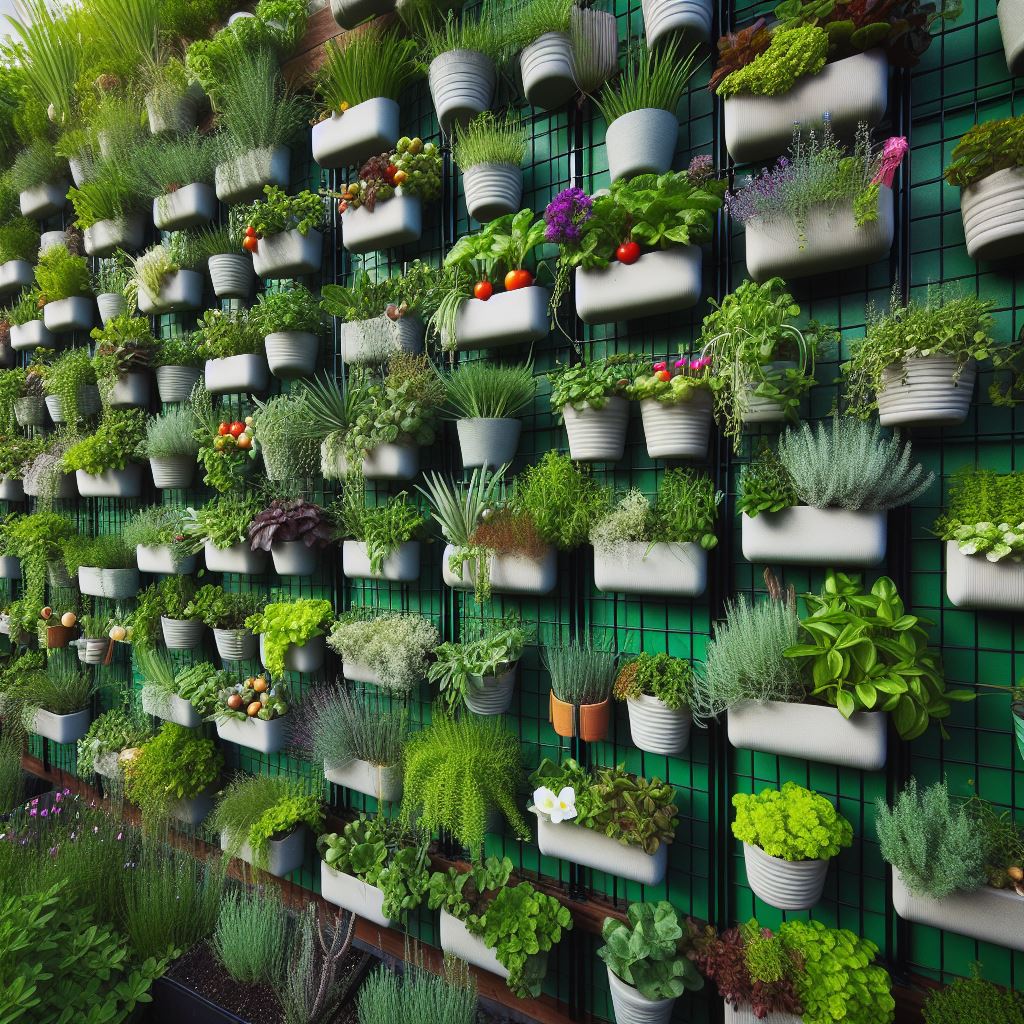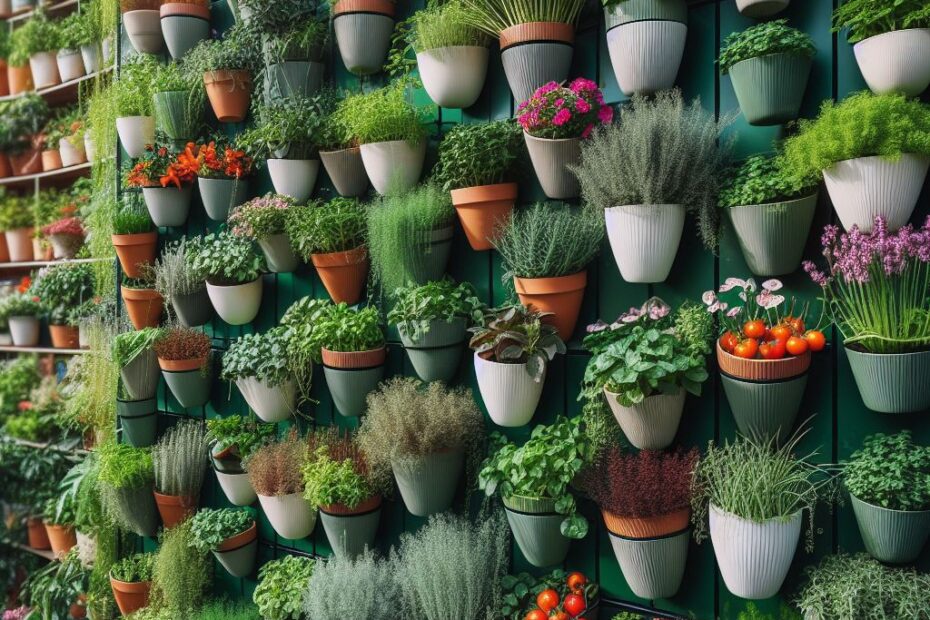I. Introduction: Embracing the Vertical Frontier
In the bustling world of urban living, where space is a coveted luxury, a new trend is taking root: vertical gardening. This innovative approach to cultivating greenery is sprouting up in cities worldwide, igniting a fervor among gardening enthusiasts and urban dwellers alike.
The Rising Trend of Vertical Gardening
Vertical gardening, once a niche concept, is now blooming into a mainstream movement. With the ever-increasing urbanization and the shrinking footprint of outdoor spaces, people are turning to vertical gardening as a solution to cultivate lush greenery in tight quarters.

Why Vertical Gardening is Gaining Popularity
The allure of vertical gardening lies in its ability to defy spatial constraints. It offers a verdant sanctuary where nature thrives even in the most limited of spaces, from cramped balconies to urban rooftops. As the quest for sustainable living intensifies, vertical gardening emerges as a practical and aesthetically pleasing way to reconnect with the natural world amidst concrete jungles.
A Brief Overview of Vertical Gardening
Vertical gardening transcends traditional horizons, embracing a vertical canvas to paint nature’s beauty. It involves the artful arrangement of plants in tiers or columns, utilizing walls, trellises, and structures as living canvases. From cascading vines to flourishing herbs, the possibilities are as endless as the sky above.
II. The Basics of Vertical Gardening: Reaching New Heights
In the verdant world of gardening, vertical gardening stands tall as a beacon of innovation and ingenuity. Understanding its fundamentals is key to unlocking the full potential of this transformative practice.
Defining Vertical Gardening: What Sets It Apart?
Vertical gardening transcends the confines of traditional gardening by embracing the vertical dimension. Instead of spreading horizontally, plants ascend skyward, adorning walls, trellises, and other vertical structures with lush foliage and vibrant blooms. This upward journey not only redefines the concept of gardening but also reimagines urban landscapes as thriving green havens.
Maximizing Space Efficiency Through Vertical Gardening
One of the defining features of vertical gardening is its unparalleled ability to maximize space efficiency. In the realm of urban living, where every square inch counts, vertical gardens offer a solution to the perennial space crunch. By harnessing vertical surfaces that would otherwise remain barren, gardeners can transform even the smallest nooks and crannies into flourishing oases of greenery.
Exploring Different Structures and Setups for Vertical Gardens
The beauty of vertical gardening lies in its versatility, offering a myriad of structures and setups to suit every space and aesthetic preference. From sleek and modern living walls to rustic trellises dripping with foliage, the options are as diverse as the imagination allows. Whether indoors or outdoors, vertical gardens breathe life into any environment, adding depth, texture, and character to every corner they adorn.
III. Getting Started: Cultivating Your Vertical Eden
Embarking on the journey of vertical gardening requires not only passion but also a basic understanding of the essential tools, materials, and techniques to bring your green vision to life.
A Rundown of Necessary Tools and Materials
Before diving into the world of vertical gardening, it’s essential to equip yourself with the right tools and materials. From sturdy trellises and planters to quality soil and fertilizer, each component plays a crucial role in nurturing your vertical oasis. Investing in durable tools and high-quality materials ensures a solid foundation for your garden to thrive.
Tips for Selecting the Right Plants for Vertical Gardening
Choosing the perfect plants for your vertical garden is akin to selecting actors for a grand theatrical performance—each plant must play its part harmoniously. Consider factors such as light exposure, climate conditions, and available space when curating your green ensemble. Opt for compact and trailing varieties that thrive in vertical environments, such as ferns, succulents, and trailing vines, to create a captivating tapestry of textures and colors.
Understanding the Importance of Proper Drainage and Irrigation Systems
In the realm of gardening, proper drainage and irrigation are the unsung heroes that sustain life and vitality. Adequate drainage prevents waterlogged soil and root rot, while efficient irrigation ensures plants receive the moisture they need to flourish. Incorporating drainage holes in planters, using lightweight soil mixes, and implementing drip irrigation systems are essential strategies to maintain optimal growing conditions in your vertical garden oasis.
IV. Designing Your Vertical Garden: Crafting Nature’s Tapestry
Designing a vertical garden is akin to orchestrating a symphony of nature—a harmonious blend of form, function, and aesthetics that transforms ordinary spaces into lush green sanctuaries.
Factors to Consider When Planning Your Vertical Garden Layout
Before laying the first stone or planting the initial seed, thoughtful consideration of your vertical garden’s layout is paramount. Assess factors such as available space, structural integrity, and environmental conditions to create a blueprint that seamlessly integrates with its surroundings. A well-planned layout maximizes visual impact while ensuring optimal growing conditions for your botanical ensemble.
Incorporating Aesthetic Elements and Functional Design Features
A successful vertical garden is a marriage of beauty and utility, where form meets function in perfect harmony. Integrate elements of texture, color, and contrast to evoke a sense of natural splendor, while incorporating practical features such as built-in irrigation systems and integrated lighting for added functionality. Embrace creativity and innovation to sculpt a garden that captivates the senses and transcends conventional boundaries.
Balancing Sunlight Exposure and Plant Placement
In the dance of light and shadow, finding the perfect balance is essential to the success of your vertical garden. Consider the sun’s trajectory throughout the day and the varying light requirements of your plant selection. Place sun-loving specimens where they can bask in the warm embrace of sunlight, while providing shade-loving varieties with sheltered alcoves to thrive. By strategically positioning plants based on their light preferences, you create a dynamic interplay of illumination that enhances the visual allure of your vertical oasis.
V. Planting and Maintenance Tips: Nurturing Nature’s Bounty
Planting and maintaining a vertical garden is not merely a task—it’s a labor of love that requires patience, diligence, and a green thumb. Mastering the art of cultivation ensures that your verdant paradise flourishes year-round.
Step-by-Step Guide to Planting Your Vertical Garden
Planting a vertical garden is akin to composing a living masterpiece—one plant at a time. Begin by selecting healthy specimens suited to your environment and desired aesthetic. Prepare the planting area by amending the soil with organic matter and ensuring adequate drainage. Plant your green companions with care, allowing ample space for growth and airflow between specimens. Finally, water gently and mulch to conserve moisture and suppress weeds, laying the foundation for a thriving vertical oasis.
Strategies for Maintaining Healthy Plants and Preventing Common Issues
Like any living organism, plants require attentive care to thrive. Monitor your vertical garden regularly, keeping an eye out for signs of stress, disease, or pest infestation. Implement proactive measures such as pruning, grooming, and removing dead or diseased foliage to promote vigorous growth and prevent the spread of ailments. By fostering a healthy ecosystem and practicing good garden hygiene, you safeguard the vitality of your botanical haven against common threats.
Recommended Watering and Fertilizing Schedules for Vertical Gardens
Water is the lifeblood of any garden, and proper hydration is paramount to the health and vitality of your vertical oasis. Establish a consistent watering schedule, taking into account factors such as climate, season, and plant species. Aim to keep the soil evenly moist, avoiding both drought stress and waterlogged conditions. Supplement regular watering with periodic fertilization using organic or slow-release fertilizers to provide essential nutrients and support robust growth. By nurturing your vertical garden with care and intention, you cultivate a verdant sanctuary that flourishes with each passing season.
VI. Benefits of Vertical Gardening: Cultivating Sustainable Serenity
Beyond its ornamental allure, vertical gardening serves as a catalyst for environmental stewardship and urban renewal, offering a multitude of benefits that resonate far beyond the confines of its green walls.
Environmental Benefits: Improving Air Quality and Reducing Urban Heat Island Effect
Vertical gardening emerges as a champion of environmental sustainability, combating urban pollution and mitigating the adverse effects of climate change. By harnessing the natural filtration capabilities of plants, vertical gardens purify the air, removing harmful toxins and pollutants while replenishing oxygen levels. Additionally, their cooling effect helps mitigate the urban heat island effect, reducing ambient temperatures and creating microclimates of comfort amidst the concrete jungle.
Space-Saving Advantages for Urban Dwellers and Small-Space Gardeners
In the labyrinthine landscapes of urban living, space is a precious commodity—yet vertical gardening offers a solution that transcends spatial constraints. Compact and efficient, vertical gardens maximize vertical real estate, transforming balconies, rooftops, and even interior walls into verdant sanctuaries of serenity. For small-space gardeners and urban dwellers alike, vertical gardening represents a pathway to sustainable self-sufficiency and green living in even the most confined of spaces.
Enhancing Aesthetic Appeal and Creating a Tranquil Oasis in Any Setting
At its essence, vertical gardening is an art form—an expression of creativity and harmony that transcends the boundaries of conventional landscaping. By layering textures, colors, and forms, vertical gardens transform mundane spaces into vibrant tapestries of natural beauty, enhancing aesthetic appeal and evoking a sense of tranquility in any setting. Whether nestled in a bustling cityscape or adorning a suburban backyard, vertical gardens offer a respite from the chaos of modern life, inviting contemplation and connection with the natural world.
VII. Overcoming Challenges: Nurturing Resilience in the Vertical Realm
While the journey of vertical gardening is rife with boundless beauty and promise, it is not without its share of challenges. By embracing resilience and ingenuity, gardeners can navigate obstacles and cultivate thriving green sanctuaries that defy the odds.
Addressing Potential Challenges Such as Limited Sunlight and Space Constraints
In the ever-shifting landscape of urban environments, limited sunlight and space constraints pose formidable challenges to vertical gardeners. To overcome these obstacles, leverage creative solutions such as selecting shade-tolerant plants for low-light areas and optimizing vertical structures to maximize exposure to natural light. Embrace the versatility of vertical gardening by exploring innovative techniques such as hydroponics and aeroponics, which require minimal space and offer greater flexibility in plant placement.
Strategies for Pest and Disease Management in Vertical Gardens
Pests and diseases are unwelcome guests in any garden, threatening to derail the delicate balance of nature. Employ proactive measures such as companion planting and biological pest control to deter unwanted invaders while fostering a healthy ecosystem that naturally resists disease. Regular monitoring and prompt intervention are key to identifying and addressing pest and disease outbreaks before they escalate, ensuring the long-term vitality of your vertical garden oasis.
Troubleshooting Common Issues and Finding Creative Solutions
From wilting foliage to nutrient deficiencies, common issues can arise in even the most meticulously tended vertical gardens. Arm yourself with knowledge and resources to troubleshoot problems as they arise, whether it be adjusting watering schedules, amending soil composition, or implementing integrated pest management strategies. Embrace the spirit of experimentation and innovation, drawing inspiration from fellow gardeners and experts to devise creative solutions that nurture resilience and foster growth in the face of adversity.
VIII. Real-Life Inspirations: Vertical Gardens Around the World
Embark on a journey across continents and cultures to discover the awe-inspiring wonders of vertical gardens—the living tapestries that defy convention and redefine urban landscapes with their verdant splendor.
Highlighting Innovative Vertical Garden Designs and Installations
From the lush jungles of South America to the bustling streets of Asia, vertical gardens have captured the imagination of architects and designers worldwide. Explore iconic landmarks such as the Gardens by the Bay in Singapore, where towering Supertrees adorned with vertical gardens create an otherworldly oasis amidst the city’s skyline. Marvel at the innovative designs of Patrick Blanc, whose pioneering work in vertical gardening has inspired a generation of green enthusiasts to reimagine the possibilities of urban greening.
Case Studies of Successful Vertical Gardening Projects in Various Environments
Dive deep into the success stories of vertical gardening projects in diverse environments, from arid deserts to bustling metropolises. Discover how communities in drought-prone regions harness the power of vertical gardens to conserve water and combat desertification, transforming barren landscapes into thriving hubs of biodiversity and sustainability. Explore the symbiotic relationship between nature and architecture as vertical gardens seamlessly integrate with urban infrastructure, blurring the boundaries between built and natural environments.
Drawing Inspiration from Renowned Vertical Garden Architects and Designers
Celebrate the visionaries and trailblazers who have shaped the landscape of vertical gardening with their innovative designs and boundless creativity. From the visionary concepts of landscape architect Stefano Boeri to the avant-garde installations of artist Patric Blanc, each luminary brings a unique perspective to the art of vertical gardening, pushing the boundaries of design and sustainability with their daring creations. Draw inspiration from their works of art as you embark on your own vertical gardening journey, weaving dreams into reality one leaf at a time.
IX. Conclusion: Embracing the Vertical Frontier
As we bid farewell to this exploration of vertical gardening, we are reminded of its enduring allure and transformative power—a testament to the resilience of nature and the human spirit.
Recap of the Benefits and Appeal of Vertical Gardening
Vertical gardening, with its boundless beauty and practicality, offers a myriad of benefits that resonate far beyond the confines of its green walls. From its environmental benefits, including improved air quality and urban cooling, to its space-saving advantages for urban dwellers and small-space gardeners, vertical gardening represents a harmonious union of form and function. Its ability to enhance aesthetic appeal and create tranquil oases in any setting elevates the human experience, fostering connection and renewal in the heart of urban environments.
Encouragement for Readers to Embark on Their Own Vertical Gardening Journey
As we reflect on the wonders of vertical gardening, we extend an invitation—a call to action for readers to embark on their own green odyssey. Whether you dwell in a bustling metropolis or a quaint countryside, the vertical frontier beckons, offering endless possibilities for creativity, sustainability, and connection with the natural world. With determination and passion as your guiding lights, may you cultivate thriving green sanctuaries that inspire and nourish both body and soul.
Final Thoughts on the Transformative Power of Green Spaces in Urban Environments
In the tapestry of urban life, green spaces serve as beacons of hope and renewal, breathing life into the concrete jungle and nurturing the seeds of change. As we embrace the transformative power of green spaces, let us not only cultivate gardens but cultivate communities—spaces where nature and humanity coexist in harmony, fostering resilience, diversity, and abundance for generations to come.



